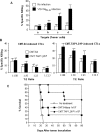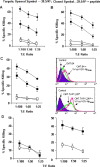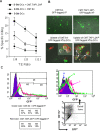Trogocytosis of MHC-I/peptide complexes derived from tumors and infected cells enhances dendritic cell cross-priming and promotes adaptive T cell responses
- PMID: 18769733
- PMCID: PMC2518214
- DOI: 10.1371/journal.pone.0003097
Trogocytosis of MHC-I/peptide complexes derived from tumors and infected cells enhances dendritic cell cross-priming and promotes adaptive T cell responses
Abstract
The transporter associated with antigen processing (TAP) and the major histocompatibility complex class I (MHC-I), two important components of the MHC-I antigen presentation pathway, are often deficient in tumor cells. The restoration of their expression has been shown to restore the antigenicity and immunogenicity of tumor cells. However, it is unclear whether TAP and MHC-I expression in tumor cells can affect the induction phase of the T cell response. To address this issue, we expressed viral antigens in tumors that are either deficient or proficient in TAP and MHC-I expression. The relative efficiency of direct immunization or immunization through cross-presentation in promoting adaptive T cell responses was compared. The results demonstrated that stimulation of animals with TAP and MHC-I proficient tumor cells generated antigen specific T cells with greater killing activities than those of TAP and MHC-I deficient tumor cells. This discrepancy was traced to differences in the ability of dendritic cells (DCs) to access and sample different antigen reservoirs in TAP and MHC-I proficient versus deficient cells and thereby stimulate adaptive immune responses through the process of cross-presentation. In addition, our data suggest that the increased activity of T cells is caused by the enhanced DC uptake and utilization of MHC-I/peptide complexes from the proficient cells as an additional source of processed antigen. Furthermore, we demonstrate that immune-escape and metastasis are promoted in the absence of this DC 'arming' mechanism. Physiologically, this novel form of DC antigen sampling resembles trogocytosis, and acts to enhance T cell priming and increase the efficacy of adaptive immune responses against tumors and infectious pathogens.
Conflict of interest statement
Figures







Similar articles
-
Spotlight on TAP and its vital role in antigen presentation and cross-presentation.Mol Immunol. 2022 Feb;142:105-119. doi: 10.1016/j.molimm.2021.12.013. Epub 2021 Dec 29. Mol Immunol. 2022. PMID: 34973498 Free PMC article. Review.
-
Bacterial antigen delivery systems: phagocytic processing of bacterial antigens for MHC-I and MHC-II presentation to T cells.Behring Inst Mitt. 1997 Feb;(98):197-211. Behring Inst Mitt. 1997. PMID: 9382741 Review.
-
Combining the antigen processing components TAP and Tapasin elicits enhanced tumor-free survival.Clin Cancer Res. 2008 Mar 1;14(5):1494-501. doi: 10.1158/1078-0432.CCR-07-1066. Clin Cancer Res. 2008. PMID: 18316574
-
Chlamydia trachomatis Infection Impairs MHC-I Intracellular Trafficking and Antigen Cross-Presentation by Dendritic Cells.Front Immunol. 2021 Apr 15;12:662096. doi: 10.3389/fimmu.2021.662096. eCollection 2021. Front Immunol. 2021. PMID: 33936099 Free PMC article.
-
IFN-γ treatment protocol for MHC-Ilo/PD-L1+ pancreatic tumor cells selectively restores their TAP-mediated presentation competence and CD8 T-cell priming potential.J Immunother Cancer. 2020 Aug;8(2):e000692. doi: 10.1136/jitc-2020-000692. J Immunother Cancer. 2020. PMID: 32868392 Free PMC article.
Cited by
-
Different functional outcomes of intercellular membrane transfers to monocytes and T cells.Cell Mol Life Sci. 2010 Apr;67(7):1133-45. doi: 10.1007/s00018-009-0239-4. Cell Mol Life Sci. 2010. PMID: 20238479 Free PMC article.
-
Dynamics of macrophage trogocytosis of rituximab-coated B cells.PLoS One. 2011 Jan 17;6(1):e14498. doi: 10.1371/journal.pone.0014498. PLoS One. 2011. PMID: 21264210 Free PMC article.
-
Shaping of T Cell Functions by Trogocytosis.Cells. 2021 May 10;10(5):1155. doi: 10.3390/cells10051155. Cells. 2021. PMID: 34068819 Free PMC article. Review.
-
Vaccine-induced antigen archiving enhances local memory CD8+ T cell responses following an unrelated viral infection.Res Sq [Preprint]. 2023 Sep 25:rs.3.rs-3307809. doi: 10.21203/rs.3.rs-3307809/v1. Res Sq. 2023. Update in: NPJ Vaccines. 2024 Mar 21;9(1):66. doi: 10.1038/s41541-024-00856-6. PMID: 37841845 Free PMC article. Updated. Preprint.
-
Assessing in vitro and in vivo Trogocytosis By Murine CD4+ T cells.Bio Protoc. 2020 May 5;10(9):e3607. doi: 10.21769/BioProtoc.3607. eCollection 2020 May 5. Bio Protoc. 2020. PMID: 33659572 Free PMC article.
References
-
- Jefferies WA, Kolaitis G, Gabathuler R. IFN-gamma-induced recognition of the antigen-processing variant CMT.64 by cytolytic T cells can be replaced by sequential addition of beta 2 microglobulin and antigenic peptides. J Immunol. 1993;151:2974–2985. - PubMed
-
- Seliger B, Maeurer MJ, Ferrone S. TAP off–tumors on. Immunol Today. 1997;18:292–299. - PubMed
-
- Seliger B, Maeurer MJ, Ferrone S. Antigen-processing machinery breakdown and tumor growth. Immunol Today. 2000;21:455–464. - PubMed
-
- Garcia-Lora A, Algarra I, Garrido F. MHC class I antigens, immune surveillance, and tumor immune escape. J Cell Physiol. 2003;195:346–355. - PubMed
Publication types
MeSH terms
Substances
LinkOut - more resources
Full Text Sources
Other Literature Sources
Research Materials
Miscellaneous

